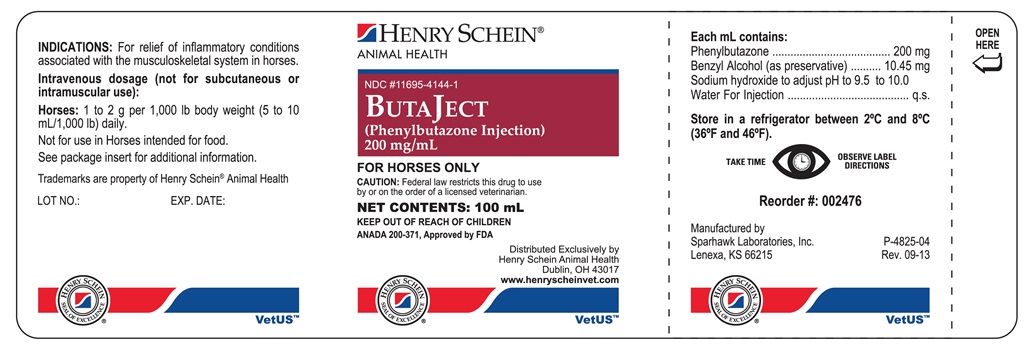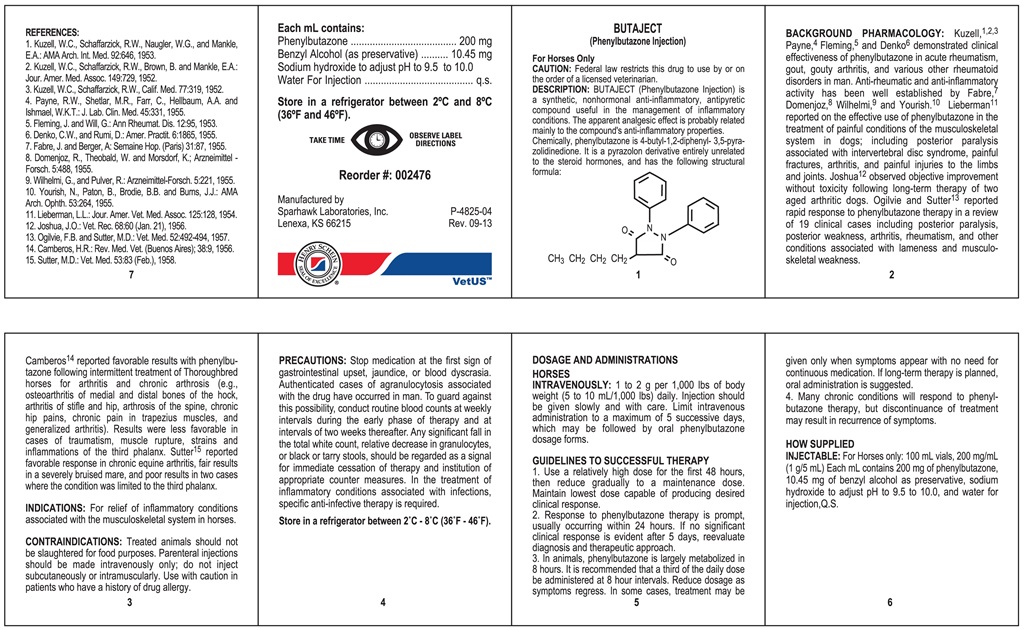BUTAJECT- phenylbutazone injection
BUTAJECT by
Drug Labeling and Warnings
BUTAJECT by is a Animal medication manufactured, distributed, or labeled by Butler Animal Health Supply. Drug facts, warnings, and ingredients follow.
Drug Details [pdf]
- GENERAL PRECAUTIONS
-
DESCRIPTION
DESCRIPTION: Phenylbutazone 20% Injection (phenylbutazone) is a synthetic, nonhormonal anti-inflammatory, antipyretic compound useful in the management of inflammatory conditions. The apparent analgesic effect is probably related mainly to the compound's anti-inflammatory properties. Chemically, phenylbutazone is 4-butyl-1,2-diphenyl-3,5-pyrazolidinedione. It is a pyrazolon derivative entirely unrelated to the steroid hormones, and has the following structural formula:

-
BACKGROUND PHARMACOLOGY
Kuzell, 1, 2, 3 Payne,4 Fleming,5 and Denko6 demonstrated clinical effectiveness of phenylbutazone in acute rheumatism, gout, gouty arthritis and various other rheumatoid disorders in man. Anti-rheumatic and anti-inflammatory activity has been well established by Fabre,7 Domenjoz,8 Wilhelmi,9 and Yourish.10 Lieberman 11 reported on the effective use of phenylbutazone in the treatment of painful conditions of the musculosketal system in dogs; including posterior paralysis associated with intervertebral disc syndrome, painful fractures, arthritis, and painful injuries to the limbs and joints. Joshua12 observed objective improvement without toxicity following long-term therapy of two aged arthritic dogs. Ogilvie and Sutter13 reported rapid response to phenylbutazone therapy in a review of 19 clinical cases including posterior paralysis, posterior weakness, arthritis, rheumatism, and other conditions associated with lameness and musculoskeletal weakness.
Camberos14 reported favorable results with phenylbutazone following intermittent treatment of Thoroughbred horses for arthritis and chronic arthrosis (e.g., osteoarthritis of medial and distal bones of the hock, arthritis of stifle and hip, arthrosis of the spine, chronic hip pains, achronic pain in the trapezius muscles, and generalized arthritis). Results were less favorable in cases of traumatism, muscle rupture, strains and inflammations of the third phalanx. Sutter15 reported favorable response in chronic equine arthritis, fair results in a severely bruised mare, and poor results in two cases where the condition was limited to the third phalanx
- INDICATIONS
- CONTRAINDICATIONS
-
PRECAUTIONS
Stop medication at the first sign of gastrointestinal upset, jaundice, or blood dyscrasia. Authenticated cases of agranulocytosis associated with the drug have occurred in man. To guard against this possibility, conduct routine blood counts at weekly intervals of two weeks thereafter. Any significant fall in th total white count, relative decrease in granulocytes, or black or tarry stools, should be regarded as a signal for immediate cessation of therapy and institution of appropriate counter measures. In the treatment of inflammatory conditions associated with infections, specific anti-infective therapy is required.
- STORAGE AND HANDLING
-
DOSAGE AND ADMINISTRATION
HORSES
INTRAVENOUSLY: 1 to 2 g per 1,000 lbs of body weight (5 to 10 mL/1,000 lbs) daily. Injection should be given slowly and with care. Limit intravenous administration to a maximum of 5 successive days, which may be followed by oral phenylbutazone dosage forms.GUIDELINES TO SUCCESSFUL THERAPY
1. Use a relatively high dose for the first 48 hours, then reduce gradually to a maintenance dose. Maintain lowest dose capable of producing desired clinical response.
2. Response to phenylbutazone therapy is prompt, usually occurring within 24 hours. If no significant clinical response is evident after 5 days, reevaluate diagnosis and therapeutic approach.
3. In animals, phenylbutazone is largely metabolized in 8 hours. It is recommended that a third of the daily dose be administered at 8 hour intervals. Reduce dosage as symptoms regress. In some cases, treatment may be given only when symptoms appear with no need for continuous medication. If long-term therapy is planned, oral administration is suggested.
4. Many chronic conditions will respond to phenylbutazone therapy, but discontinuance of treatment may result in recurrence of symptoms.
- HOW SUPPLIED
-
REFERENCES
1. Kuzell, W.C., Schaffarzick, R.W., Naugler, W.G., and Mankle, E.A.: AMA Arch. Int. Med. 92:646, 1953.
2. Kuzell, W.C., Schaffarzick, R.W., Brown, B. and Mankle, E.A.: Jour. Amer. Med. Assoc. 149:729, 1952.
3. Kuzell, W.C., Schaffarzick, R.W., Calif. Med. 777:319, 1952.
4. Payne, R.W., Shetlar, M.R., Farr, C., Hellbaum, A.A., and Ishmael, W.K.T.: J.Lab. Clin. Med. 45:331, 1955.
5. Fleming, J. and @Will, G.: Ann Rheumat. Dis. 12:95, 1953.
6. Denko, C.W., and Rumi, D.: Amer. Practit. 6:1865, 1955.
7. Fabre, J. and Berger, A.: Semaine Hop. (Paris) 31:87, 1955.
8. Domenjoz, R., Theobald, W. and Morsdorf, K., Arzneimittel-Forsch. 5:488, 1955.
9 Wilhelmi, G., and Pulver, R.: Arzneimittel-Forsch. 5:221, 1955.
10. Yoursh, N., Paton, B., Brodie, B.B and Burns, J.J.: AMA Arch. Ophth. 53:264, 1955.
11. Lieberman, L.L.: Jour. Amer. Vet. Med. Assoc. 125:128, 1954.
12. Joshua, J.O.: Vet. Rec. 68:60 (Jan 21), 1956.
13. Ogilvie, F.B. and Sutter, M.D.: Vet. Med 52:492-494, 1957.
14. Camberos, H.R.: Rev. Med. Vet. (Buenos Aires); 38:9, 1956.
15. Sutter, M.F.: Vet Med. 53:83 (Feb.), 1958.
-
INDICATIONS
For relief of inflammatory conditions associated with the musculoskeletal system in horses.
Intravenous dosage (not subcutaneous or intramuscular use):
Horses: 1 to 2 g per 1,000 lb body weight (5 to 10 mL/1,000 lb) daily.
Not for use in Horses intended for food.
See package outsert for additional information.
Each mL contains:
Phenylbutazone ............................. 200 mg
Benzyl Alcohol Preservative .........10.45 mg
Sodium hydroxide to adjust pH to 9.5 to 10.0
Water For Injection ...............................q.s.
Store in a refrigerator between 2oC and 8oC (36oF and 46oF).
TAKE TIME OBSERVE LABEL DIRECTIONS
- PRINCIPAL DISPLAY PANEL
-
INGREDIENTS AND APPEARANCE
BUTAJECT
phenylbutazone injectionProduct Information Product Type PRESCRIPTION ANIMAL DRUG Item Code (Source) NDC: 11695-4144 Route of Administration INTRAVENOUS Active Ingredient/Active Moiety Ingredient Name Basis of Strength Strength PHENYLBUTAZONE (UNII: GN5P7K3T8S) (PHENYLBUTAZONE - UNII:GN5P7K3T8S) PHENYLBUTAZONE 200 mg in 1 mL Packaging # Item Code Package Description Marketing Start Date Marketing End Date 1 NDC: 11695-4144-1 100 mL in 1 VIAL Marketing Information Marketing Category Application Number or Monograph Citation Marketing Start Date Marketing End Date ANADA ANADA200371 02/18/2009 Labeler - Butler Animal Health Supply (017880659)
© 2025 FDA.report
This site is not affiliated with or endorsed by the FDA.

